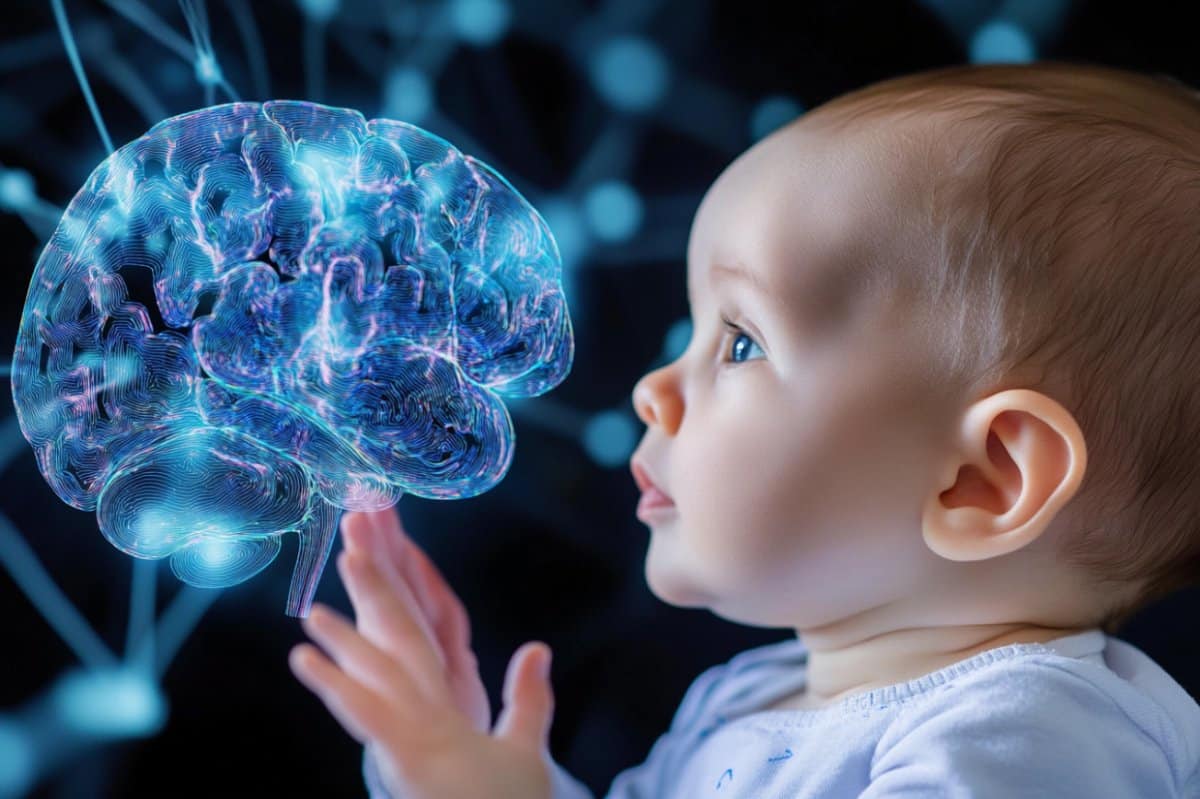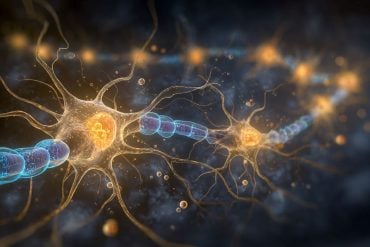Summary: The brain’s white matter microstructure at just three months of age can predict how an infant’s emotions will develop over time. Using an advanced imaging technique called NODDI, scientists mapped the organization of neural pathways that govern emotional processing.
They found that specific brain tracts were linked to increases in either positive or negative emotionality by nine months. Infants with more complex microstructure in the left cingulum bundle displayed more positive emotions and better self-soothing.
Key Facts:
- Early Emotional Forecasting: White matter structure at 3 months predicts emotional patterns by 9 months.
- Distinct Pathways: Forceps minor linked to negative emotionality; cingulum bundle linked to positive growth.
- New Imaging Standard: NODDI imaging provides detailed insight into infant brain development previously unseen.
Source: Genomic Press
In a comprehensive Genomic Press research article, scientists have uncovered remarkable insights into how the earliest brain connections shape infant emotional development, potentially offering new ways to identify children at risk for future behavioral and emotional challenges.
The groundbreaking study, led by Dr. Yicheng Zhang and Dr. Mary L. Phillips at the University of Pittsburgh School of Medicine, examined 95 infant-caregiver pairs using advanced brain imaging techniques. Researchers discovered that the microstructure of white matter tracts – the brain’s information highways – at just 3 months of age could predict how infants’ emotions and self-soothing abilities would evolve over the following six months.

Decoding the Infant Brain’s Emotional Blueprint
The research team employed sophisticated Neurite Orientation Dispersion and Density Imaging (NODDI), a cutting-edge MRI technique that provides unprecedented detail about brain tissue organization.
This technology allowed scientists to peer into the developing brain’s architecture with remarkable precision, revealing how the arrangement of neural fibers influences emotional trajectories.
“What we’re seeing is that the brain’s structural organization in early infancy sets the stage for emotional development,” explains the research team.
The study focused on critical white matter pathways connecting regions responsible for self-awareness, attention to important stimuli, and cognitive control – networks that form the foundation of emotional processing throughout life.
Key Discoveries Shape Understanding of Emotional Development
The findings revealed distinct patterns linking brain structure to emotional outcomes. Infants with higher neurite dispersion in the forceps minor – a bundle of fibers connecting the brain’s hemispheres – showed greater increases in negative emotionality between 3 and 9 months. This suggests that certain patterns of brain connectivity might predispose infants to heightened emotional reactivity.
Conversely, infants with more complex microstructure in the left cingulum bundle, which connects regions involved in executive control, demonstrated larger increases in positive emotions and improved self-soothing abilities.
These discoveries raise intriguing questions about whether early interventions could potentially influence these neural pathways to promote healthier emotional development.
Implications for Early Detection and Intervention
The ability to identify infants at risk for emotional difficulties before behavioral symptoms emerge represents a significant advance in developmental neuroscience.
Previous research has established that high negative emotionality in infancy correlates with increased risk for future anxiety and behavioral disorders, while low positive emotionality links to later depression and social difficulties.
Dr. Phillips notes the potential impact: “Understanding these early neural markers could transform how we approach infant mental health, allowing for targeted interventions during critical developmental windows.”
The research team validated their findings in an independent sample of 44 infants, strengthening confidence in these brain-behavior relationships.
Advanced Imaging Reveals Hidden Patterns
The study’s use of NODDI technology marks a significant methodological advance in infant brain research. Traditional imaging methods often struggle to capture the nuanced organization of developing brain tissue. NODDI’s ability to separate different tissue components provides researchers with a clearer picture of how neural pathways mature and organize during this crucial period.
The research examined three major white matter tracts: the forceps minor, cingulum bundle, and uncinate fasciculus. Each plays a vital role in connecting brain regions essential for emotional processing and regulation.
How might variations in other brain connections influence infant development? What role do environmental factors play in shaping these neural pathways?
Bridging Neuroscience and Clinical Practice
The findings have immediate relevance for pediatric care and early childhood development. By identifying objective neural markers of emotional development, clinicians could potentially screen for risk factors before behavioral problems emerge. This proactive approach could lead to earlier, more effective interventions.
The research team accounted for multiple factors that might influence brain development, including caregiver mental health, socioeconomic status, and infant characteristics.
This comprehensive approach strengthens the study’s conclusions and suggests that brain microstructure represents a fundamental contributor to emotional development independent of environmental influences.
Future Directions and Unanswered Questions
While these findings represent a significant advance, they also open new avenues for investigation.
How stable are these early neural patterns throughout childhood? Can targeted interventions modify white matter development to promote emotional resilience?
The research team’s ongoing work aims to address these questions through longitudinal studies following infants into later childhood.
The study also highlights the importance of the first year of life as a critical period for brain development. During this time, rapid changes in white matter organization lay the foundation for lifelong emotional and behavioral patterns. Understanding these processes at a neural level could inform everything from parenting practices to public health policies supporting infant development.
A New Era in Developmental Neuroscience
This research exemplifies the power of advanced neuroimaging to reveal previously hidden aspects of brain development. As technology continues to evolve, scientists gain increasingly sophisticated tools to understand how the brain’s earliest organization shapes human behavior and experience.
The University of Pittsburgh team’s findings contribute to a growing body of evidence suggesting that many aspects of emotional and behavioral development have roots in the brain’s earliest structural patterns. By identifying these patterns, researchers move closer to developing targeted interventions that could prevent or mitigate future mental health challenges.
The implications extend beyond individual children to broader questions about human development. How do genetic and environmental factors interact to shape these early brain patterns? What evolutionary advantages might different patterns of emotional development confer? These fundamental questions drive continued research in this rapidly advancing field.
The study demonstrates that even in the earliest months of life, the brain’s structural organization profoundly influences emotional development. This knowledge opens new possibilities for supporting healthy development from the very beginning of life.
About this emotion and neurodevelopment research news
Author: Ma-Li Wong
Source: Genomic Press
Contact: Ma-Li Wong – Genomic Press
Image: The image is credited to Neuroscience News
Original Research: Open access.
“Early infant white matter tract microstructure predictors of subsequent change in emotionality and emotional regulation” by Yicheng Zhang et al. Genomic Psychiatry
Abstract
Early infant white matter tract microstructure predictors of subsequent change in emotionality and emotional regulation
There are rapid changes in negative and positive emotionality (NE, PE) and emotional regulation (e.g., soothability) during the first year of life. Understanding the neural basis of these changes during maturation can enhance the understanding of the etiology of early psychopathology.
Our goal was to determine how measures of white matter (WM) microstructure in tracts connecting key emotion-related neural networks, including the forceps minor (FM), cingulum bundle (CB), and uncinate fasciculus interconnecting the default mode network (DMN), salience network (SN), and central executive network (CEN), can predict developmental change in infant emotionality and emotional regulation.
We used Neurite Orientation Dispersion and Density Imaging (NODDI) measures together with conventional diffusion tensor metrics to examine WM tract microstructure and fiber collinearity in the primary sample (n = 95), and modeled each WM feature with caregiver-reported infant NE, PE, and soothability, with infant and caregiver sociodemographic factors as covariates.
In 3-month infants, higher neurite dispersion and lower longitudinal fiber alignment in the FM were associated with a larger increase in NE from 3 to 9 months of age, suggesting that greater integration of the DMN, SN, and CEN leads to a larger subsequent increase in NE; while higher neurite density and dispersion as well as lower WM longitudinal alignment in the left CB were associated with a larger increase in PE, suggesting that greater integration within the CEN leads to increasing PE over time.
In addition, higher neurite dispersion and lower WM longitudinal alignment in the left CB were associated with a larger increase in soothability.
Associations among diffusion tensor measures and changes in infant emotionality and emotional regulation measures were replicated in an independent test sample (n = 44).
These findings suggest that early infant WM microstructural features support infant emotionality and emotional regulation development and could represent early biomarkers of future emotional and behavioral disorders.






